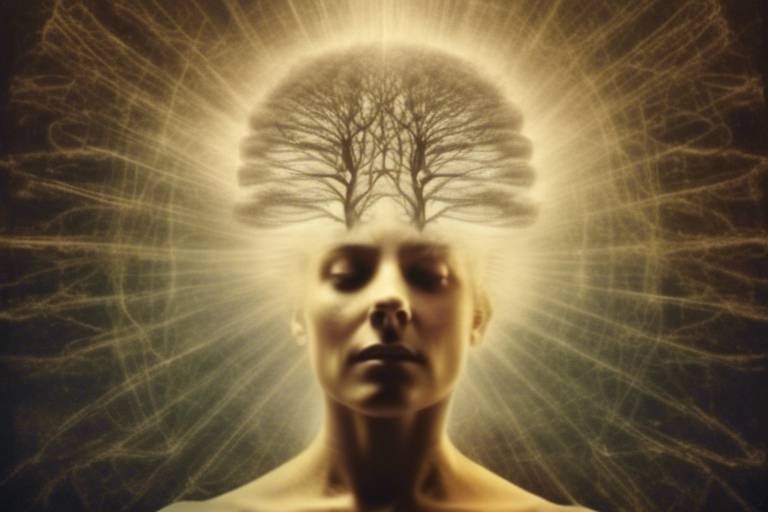Metaphysics - The Undeniable Power of Thoughts
Have you ever paused to consider the immense power your thoughts hold? Metaphysics, a branch of philosophy that explores the fundamental nature of reality, dives deep into this fascinating concept. It’s not just about abstract theories; it’s about understanding how our thoughts shape our experiences and ultimately, our lives. Imagine your mind as a powerful magnet, attracting experiences that resonate with your thoughts. This article will take you on a journey through the realms of metaphysics, exploring how your mindset can create your reality.
At its core, metaphysics challenges us to question what we perceive as reality. Are the experiences we encounter a product of the world around us, or do our thoughts play a crucial role in crafting them? Think about it: when you wake up feeling positive and motivated, doesn’t the day seem to unfold in a more favorable light? Conversely, on days when negativity creeps in, it can feel as though the universe is conspiring against you. This dynamic interplay between thought and reality is what makes metaphysics not just a theoretical exercise, but a practical guide to living a fulfilling life.
As we delve deeper into this exploration, we’ll uncover the mind-body connection, where our thoughts can influence our physical health. Studies have shown that stress and anxiety, fueled by negative thoughts, can manifest as physical ailments. Conversely, positive thinking and visualization can lead to improved health outcomes. It’s like tuning a radio; when you adjust the frequency, you get a clearer signal. By tuning our thoughts positively, we can enhance our overall well-being.
Let’s not forget the role of consciousness in this equation. Our awareness of our thoughts can significantly shape our reality. When we practice intentional thinking, we become more attuned to our experiences. It’s akin to being the director of a movie; you get to choose how the story unfolds. This awareness allows us to navigate life with purpose, making choices that align with our true desires and values.
But what about the subconscious mind? This powerful aspect of our psyche often operates below the level of conscious awareness, influencing our behaviors and decisions. Imagine it as the hidden engine of a car; while you may not see it, it drives your vehicle forward. By understanding how subconscious beliefs can manifest in our reality, we can begin to reprogram our minds for success. Techniques like visualization and affirmations can help us tap into this reservoir of potential, transforming limiting beliefs into empowering ones.
Additionally, practicing mindfulness can greatly enhance our awareness of thoughts. Mindfulness is like a mental workout; it trains our brains to focus and be present. By cultivating mindfulness, we can learn to observe our thoughts without judgment, allowing us to respond rather than react. This practice not only helps in managing stress but also empowers us to harness the power of our thoughts for personal growth and transformation.
Another fascinating aspect of metaphysics is the Law of Attraction. This principle suggests that our thoughts—whether positive or negative—attract corresponding experiences into our lives. It’s like a cosmic ordering system: when you focus on what you want, you’re more likely to receive it. Understanding and applying the Law of Attraction can be a game-changer in manifesting your desires. Imagine setting your sights on a goal and watching it unfold before your eyes, all because you believed it was possible.
As we wrap up this exploration of metaphysics, it’s essential to recognize how language shapes our thoughts and perceptions. The words we choose can significantly impact our mindset and reality. For instance, using empowering language can foster a more positive outlook, while negative language can create barriers. It’s not just about the words themselves but the energy and intention behind them. When we consciously choose our language, we can shift our mindset and, in turn, our experiences.
In conclusion, the study of metaphysics invites us to explore the undeniable power of our thoughts. By understanding the intricate connections between our minds, bodies, and the universe, we can take charge of our realities. So, the next time you find yourself caught in a web of negative thinking, remember: you have the power to change your narrative. Embrace the journey of self-discovery and watch as your thoughts transform your world.
- What is metaphysics? Metaphysics is a branch of philosophy that examines the fundamental nature of reality, exploring concepts like existence, being, and the universe.
- How do thoughts influence reality? Our thoughts shape our perceptions and experiences. Positive thoughts can attract positive experiences, while negative thoughts can lead to unfavorable outcomes.
- What is the Law of Attraction? The Law of Attraction is the belief that positive or negative thoughts bring corresponding experiences into our lives.
- How can I practice mindfulness? Mindfulness can be practiced through meditation, deep breathing exercises, and being present in the moment. It helps enhance awareness of your thoughts.

The Nature of Reality
Understanding the essence of reality is fundamental in metaphysics. It's like peeling an onion; each layer you uncover reveals deeper truths about our existence. Our perceptions and thoughts are not just passive observations of the world around us; they actively shape our experiences and influence our beliefs and actions. Imagine walking through a forest. If you approach it with a sense of wonder and curiosity, the trees seem taller, the air fresher, and the sounds more melodious. Conversely, if you're burdened by negative thoughts, the same forest can feel dark and foreboding. This illustrates how our mental state colors our reality.
At the core of this exploration is the concept that reality is not a fixed entity but rather a fluid construct influenced by our individual perceptions. Each person experiences the world through their unique lens, shaped by their thoughts, emotions, and past experiences. For instance, consider two people attending the same concert. One may feel exhilarated by the music, while the other may feel frustrated by the crowd. This divergence highlights how our internal dialogues can dictate our external experiences. In essence, we are not merely observers of reality; we are co-creators of it.
Moreover, our beliefs play a significant role in shaping our reality. Beliefs act as filters through which we interpret our experiences. If you believe that the world is a friendly place, you are more likely to encounter kindness and opportunities. On the other hand, if you harbor skepticism and distrust, you may find yourself surrounded by negativity. This dynamic is akin to wearing tinted glasses; the color of the lenses affects how you perceive everything around you.
To further illustrate this point, consider the following table that summarizes how different thoughts can lead to varying realities:
| Type of Thought | Resulting Reality |
|---|---|
| Positive Thoughts | Opportunities, Joy, Success |
| Negative Thoughts | Obstacles, Frustration, Failure |
| Neutral Thoughts | Indifference, Routine, Stability |
In conclusion, the nature of reality is intricately tied to our thoughts and perceptions. By becoming aware of this connection, we can begin to take control of our experiences and shape a reality that aligns with our desires and aspirations. So, the next time you find yourself caught in a negative thought spiral, remember: you hold the power to change your reality, one thought at a time.
- What is metaphysics? Metaphysics is a branch of philosophy that explores the fundamental nature of reality, including concepts such as existence, being, and the universe.
- How do thoughts influence reality? Our thoughts shape our perceptions and beliefs, which in turn affect how we experience the world around us.
- Can I change my reality by changing my thoughts? Yes! By cultivating positive thoughts and beliefs, you can create a more fulfilling and joyful reality.
- What is the Law of Attraction? The Law of Attraction suggests that like attracts like, meaning that positive or negative thoughts will attract corresponding experiences into your life.

The Mind-Body Connection
The intricate relationship between the mind and body is a fascinating subject that has intrigued philosophers, scientists, and everyday individuals alike. Imagine your mind as a conductor of an orchestra, directing the various instruments that represent your body. Each thought, emotion, and belief serves as a note in this symphony, creating a harmonious or discordant experience in your life. When we understand this connection, we can begin to harness the power of our thoughts to influence our physical health in profound ways.
Research has shown that our thoughts and emotions can significantly impact our physical well-being. For instance, stress and anxiety can manifest as physical symptoms, such as headaches, fatigue, and even chronic conditions. Conversely, positive thoughts and emotions can lead to improved health outcomes. This phenomenon is often referred to as the biopsychosocial model, which emphasizes the interplay between biological, psychological, and social factors in health and illness.
One of the most compelling aspects of the mind-body connection is the impact of mindfulness on our health. Mindfulness practices, such as meditation and deep-breathing exercises, have been shown to reduce stress, lower blood pressure, and enhance overall well-being. When we cultivate a state of mindfulness, we become more aware of our thoughts and feelings, allowing us to respond to them rather than react impulsively. This shift in awareness can lead to healthier lifestyle choices and improved emotional resilience.
Moreover, the mind-body connection can be illustrated through various therapeutic approaches. For example, techniques such as cognitive behavioral therapy (CBT) focus on changing negative thought patterns to positively affect emotional and physical health. By addressing the root of our thoughts, we can alleviate symptoms of anxiety, depression, and stress-related illnesses. The table below summarizes some common mind-body therapies and their benefits:
| Therapy | Description | Benefits |
|---|---|---|
| Mindfulness Meditation | A practice that encourages present-moment awareness. | Reduces stress, enhances emotional regulation, improves focus. |
| Cognitive Behavioral Therapy (CBT) | A therapeutic approach that addresses negative thought patterns. | Alleviates symptoms of anxiety and depression, improves problem-solving skills. |
| Yoga | A physical and mental practice that combines postures, breathing, and meditation. | Enhances flexibility, reduces stress, promotes relaxation. |
| Biofeedback | A technique that teaches control over physiological functions. | Improves stress management, reduces chronic pain, enhances relaxation. |
It's also essential to recognize the role of emotions in this connection. Emotions are not just fleeting feelings; they carry energy that can influence our physical state. For instance, prolonged feelings of anger or sadness can lead to physical ailments, while joy and love can promote healing and vitality. By acknowledging and processing our emotions, we can prevent them from manifesting as physical issues.
In summary, the mind-body connection is a powerful reminder that our thoughts and feelings are not isolated experiences; they directly impact our physical health. By cultivating a greater awareness of this connection, we can actively participate in our healing journey, transforming our lives through the power of our thoughts. So the next time you feel a twinge of discomfort, pause and ask yourself: what thoughts or emotions might be contributing to this experience? Your body may just be trying to communicate with you.
- What is the mind-body connection? It refers to the relationship between our thoughts, emotions, and physical health, illustrating how mental states can influence bodily conditions.
- How can I improve my mind-body connection? Practicing mindfulness, meditation, and engaging in physical activities like yoga can enhance your awareness and strengthen this connection.
- Can negative thoughts affect my health? Yes, negative thoughts can lead to stress and other physical ailments, while positive thoughts can promote healing and well-being.

The Role of Consciousness
Consciousness is like the conductor of an orchestra, skillfully guiding each thought, emotion, and perception to create the symphony of our daily experiences. It’s the lens through which we view the world, influencing not only how we interpret our surroundings but also how we react to them. When we delve into the role of consciousness in metaphysics, we uncover a fascinating interplay between awareness and reality. Have you ever wondered how a simple shift in your mindset can change your entire day? That’s the power of consciousness at work!
At its core, consciousness is about awareness. It’s that inner voice that narrates our lives, offering commentary on our thoughts and feelings. This awareness can be both a blessing and a curse. On one hand, it allows us to reflect, learn, and grow. On the other hand, it can trap us in cycles of negativity or self-doubt. Therefore, understanding the dynamics of consciousness is crucial for anyone looking to harness their thoughts effectively.
Consider this: every experience we have is filtered through our consciousness. When we approach a challenge with a positive mindset, we’re more likely to find solutions and opportunities. Conversely, if we view the same situation through a lens of fear or doubt, we may miss out on potential growth. This is where the concept of intentional thinking comes into play. By actively choosing how we think about our experiences, we can shape our reality in powerful ways.
Moreover, consciousness is not static; it evolves. Our thoughts and beliefs are influenced by a myriad of factors including culture, environment, and personal experiences. This dynamic nature of consciousness means that we have the ability to change our thought patterns and, consequently, our reality. Techniques such as meditation, journaling, and even engaging in meaningful conversations can enhance our awareness, allowing us to tap into the deeper layers of our consciousness.
To illustrate this further, let’s take a look at how different states of consciousness can affect our daily lives:
| State of Consciousness | Impact on Reality |
|---|---|
| Focused Awareness | Enhances problem-solving abilities and creativity. |
| Mind-Wandering | Can lead to new ideas but may also cause distraction. |
| Altered States (e.g., meditation) | Promotes relaxation and deeper self-awareness. |
| Negative Thought Patterns | Can create a self-fulfilling prophecy of failure or anxiety. |
As you can see, the state of our consciousness directly correlates with our experiences and outcomes. By cultivating a higher level of awareness, we can navigate through life’s challenges with greater ease and clarity. It’s about recognizing the power we hold in shaping our thoughts and, by extension, our reality.
In conclusion, consciousness is not just a passive state of being; it’s a powerful force that shapes our experiences and interactions with the world. By becoming more aware of our thoughts and their potential impact, we can consciously create a more fulfilling and enriched life. So, the next time you find yourself caught in a negative thought cycle, remember: you have the power to change the narrative!
- What is consciousness? - Consciousness refers to the state of being aware of and able to think about one's own existence, thoughts, and surroundings.
- How does consciousness affect reality? - Our state of consciousness influences how we perceive and react to our experiences, shaping our reality in significant ways.
- Can I change my consciousness? - Yes! Through practices like mindfulness, meditation, and positive thinking, you can enhance your awareness and alter your thought patterns.
- What techniques can improve consciousness? - Techniques such as meditation, journaling, and engaging in reflective conversations can help improve your consciousness and self-awareness.

The Subconscious Mind
The subconscious mind is like the backstage crew of a grand theatrical performance; it operates tirelessly behind the scenes, influencing every aspect of our lives without us even realizing it. It is a vast reservoir of thoughts, memories, and beliefs that shape our behaviors and perceptions, often in ways that are beyond our conscious awareness. Imagine trying to navigate a maze blindfolded; that’s what it’s like when we let our subconscious dictate our actions without our conscious input. The beliefs we hold in our subconscious can either propel us towards success or hold us back, often based on experiences from our past.
One fascinating aspect of the subconscious mind is its ability to manifest our thoughts into reality. Think of it as a garden; if you plant seeds of positivity and self-belief, you’ll cultivate a flourishing landscape of opportunities. Conversely, if you allow weeds of doubt and negativity to take root, they can choke the life out of your potential. The subconscious mind doesn’t differentiate between positive and negative; it simply accepts what you feed it. This is why it’s crucial to be aware of our internal dialogues and the messages we repeat to ourselves.
To illustrate this, consider the following examples of subconscious influences:
- Self-Image: If you believe you are unworthy or incapable, your subconscious will align your actions to confirm that belief, leading to a cycle of self-sabotage.
- Fears and Phobias: Many of our fears stem from past experiences stored in the subconscious. For instance, a traumatic event in childhood can manifest as a phobia in adulthood.
- Habits: Our daily habits are often governed by subconscious programming. If you’ve trained your mind to associate stress with snacking, you might find yourself reaching for chips during a tough day without even thinking about it.
Understanding the power of the subconscious mind opens the door to personal transformation. By becoming aware of the limiting beliefs that reside there, we can begin to challenge and replace them with empowering ones. Techniques such as hypnotherapy, guided visualization, and journaling can help bring these subconscious beliefs to the surface, allowing us to confront and change them. It’s like shining a flashlight into a dark corner; once you illuminate it, you can see what’s there and decide what to keep and what to discard.
Moreover, the subconscious mind is also where our intuition resides. Have you ever had a gut feeling about a situation? That’s your subconscious whispering insights based on the vast amount of information it processes. Tuning into this inner voice can lead to better decision-making and a deeper understanding of ourselves. So, how do we tap into this incredible resource? It starts with mindfulness and self-awareness. By taking time each day to reflect and listen to our thoughts, we can cultivate a more harmonious relationship with our subconscious, enabling it to work for us rather than against us.
In conclusion, the subconscious mind is a powerful ally in our quest for personal growth and self-discovery. By understanding its influence and learning how to communicate effectively with it, we can unlock new levels of potential and create a reality that aligns with our true desires. Remember, the key is to nurture your subconscious with positive thoughts and beliefs, and watch as your life transforms in miraculous ways.
1. What is the subconscious mind?
The subconscious mind is the part of our mind that stores memories, beliefs, and experiences that influence our thoughts and behaviors without our conscious awareness.
2. How does the subconscious mind affect my daily life?
It shapes your habits, self-image, and reactions to situations, often guiding your actions based on deep-seated beliefs.
3. Can I change my subconscious beliefs?
Yes! Techniques like affirmations, visualization, and mindfulness can help reprogram your subconscious mind to support more positive beliefs.
4. How can I access my subconscious mind?
Practices such as meditation, journaling, and dream analysis can help you tap into your subconscious and understand its influence on your life.

Mindfulness and Thought Awareness
In our fast-paced world, it’s all too easy to get swept away by the chaos of daily life. We often find ourselves lost in a whirlwind of thoughts, worries, and distractions. This is where mindfulness comes into play, acting as a beacon of clarity amidst the storm. Mindfulness is the practice of being present in the moment, fully engaging with our thoughts and surroundings without judgment. By cultivating mindfulness, we can develop a deeper awareness of our thought patterns, which is crucial for personal growth and transformation.
Imagine your mind as a busy highway, filled with cars zooming past—each car representing a different thought or concern. Mindfulness is akin to stepping back and observing this highway from a distance, allowing you to notice the traffic without getting caught up in it. This practice enables you to identify recurring thoughts and emotional triggers, empowering you to respond to them more consciously rather than reacting impulsively.
One effective way to enhance mindfulness is through meditation. Meditation provides a structured opportunity to focus on your breath, sensations in your body, or even a specific thought. This practice helps in quieting the mind, allowing you to connect with your inner self. Over time, you may find that you can carry this sense of awareness into your everyday life, leading to more intentional actions and decisions.
Here are some techniques to cultivate mindfulness and enhance thought awareness:
- Breathing Exercises: Take a few moments each day to focus solely on your breath. Inhale deeply through your nose, hold for a moment, and exhale slowly through your mouth. This simple act can ground you in the present.
- Body Scan: Lie down comfortably and mentally scan your body from head to toe. Notice any areas of tension or discomfort, and consciously relax those areas.
- Journaling: Writing down your thoughts can help in processing emotions and recognizing patterns. It’s a form of mindfulness that allows you to reflect on your experiences.
By implementing these techniques, you can transform your relationship with your thoughts. Instead of being overwhelmed by them, you become an observer, gaining insight into how your mind operates. This awareness can lead to profound changes in your life, helping you to break free from negative thought cycles and embrace a more positive mindset.
Ultimately, mindfulness and thought awareness are about reclaiming your power over your mind. By learning to recognize and harness the influence of your thoughts, you can shape your reality in ways you never thought possible. It’s a journey worth embarking on, one that can lead to greater happiness, fulfillment, and a deeper connection to yourself and the world around you.
Q1: What is mindfulness?
Mindfulness is the practice of being fully present in the moment and aware of your thoughts, feelings, and surroundings without judgment.
Q2: How can mindfulness improve my life?
Mindfulness can enhance your mental clarity, reduce stress, and improve emotional regulation, leading to a more fulfilling life.
Q3: Do I need to meditate to practice mindfulness?
While meditation is a powerful tool for cultivating mindfulness, you can practice mindfulness in everyday activities, such as eating or walking, by being fully present in those moments.
Q4: How long does it take to see the benefits of mindfulness?
The benefits of mindfulness can be felt almost immediately, but consistent practice over time will lead to more profound and lasting changes.

The Law of Attraction
The Law of Attraction is one of those concepts that can feel both exhilarating and a bit mystical at the same time. It suggests that our thoughts, whether positive or negative, have the power to shape our experiences and reality. Imagine standing in front of a mirror; the reflection you see is a direct result of how you perceive yourself. In the same way, the thoughts we entertain act like a mirror reflecting our life circumstances back to us. So, if you're constantly dwelling on negativity, guess what? That's what you'll attract into your life!
At its core, the Law of Attraction is all about energy. Everything around us, including our thoughts, emits a certain frequency. The universe responds to this frequency by bringing us experiences that resonate with it. Think of it like tuning into a radio station; if you want to hear your favorite song, you need to be on the right frequency. Similarly, aligning your thoughts with positive energy can help you manifest your desires. But how do we harness this power effectively?
To begin with, it’s essential to understand that the Law of Attraction isn’t just about wishful thinking. It's about intentionality and focus. Here are some practical steps to apply this powerful law in your life:
- Set Clear Intentions: Define what you truly want. Be specific! The clearer your vision, the easier it is for the universe to align with your desires.
- Visualize: Spend time each day visualizing your goals as if they have already been achieved. Feel the emotions associated with your success.
- Practice Gratitude: Cultivating a sense of gratitude for what you already have opens the door for more abundance to flow into your life.
- Take Inspired Action: While thoughts are powerful, they must be coupled with action. Stay alert for opportunities that align with your intentions.
Many people have shared their success stories about how the Law of Attraction has transformed their lives. For instance, some have manifested dream jobs, loving relationships, or even financial abundance simply by changing their thought patterns and focusing on what they truly desire. It's a bit like planting a seed; with the right care and nurturing, it can blossom into something beautiful. However, it’s important to remember that this process requires patience and persistence.
In conclusion, the Law of Attraction is an empowering tool that allows us to take control of our lives by shifting our mindset. By aligning our thoughts with our desires and taking actionable steps, we can create a reality that reflects our true aspirations. So, the next time you find yourself caught in a negative thought spiral, take a moment to pause, breathe, and redirect your focus. You have the power to change your life, one thought at a time.
Q: Does the Law of Attraction really work?
A: Yes, many people believe in its principles and have experienced positive changes in their lives by applying it. However, it requires consistent practice and a genuine belief in the process.
Q: Can negative thoughts still manifest in my life?
A: Absolutely. If you focus on negative thoughts, you may attract experiences that align with those thoughts. It's crucial to cultivate a positive mindset.
Q: How long does it take to see results?
A: Results can vary greatly from person to person. Some may see changes quickly, while others may take longer. Patience and persistence are key.
Q: Is there a scientific basis for the Law of Attraction?
A: While the Law of Attraction is primarily a philosophical concept, some psychological studies suggest that positive thinking can lead to better outcomes in life.

The Influence of Language on Thought
Language is more than just a means of communication; it is a powerful tool that shapes our thoughts and perceptions. Have you ever noticed how certain words can evoke strong emotions or vivid memories? This phenomenon is not just a coincidence; it stems from the intricate relationship between language and thought. Our choice of words can influence how we perceive the world around us, guiding our beliefs and shaping our reality. For instance, when we describe something as "challenging" rather than "impossible," we open ourselves up to possibilities rather than closing the door on them. The way we articulate our thoughts can either empower us or limit us, making it essential to be mindful of the language we use.
The concept of linguistic relativity suggests that the structure and vocabulary of our language can influence our cognitive processes. This means that speakers of different languages may perceive and think about the world in distinct ways. For example, in languages that have multiple words for "snow," speakers may have a more nuanced understanding of snow conditions than those who use a single term. This highlights how language not only reflects our thoughts but also shapes them, creating a unique lens through which we view our experiences.
Moreover, the words we use can create a self-fulfilling prophecy. When we consistently use negative language, we may inadvertently reinforce limiting beliefs about ourselves. On the other hand, positive language can uplift our spirits and encourage a more optimistic outlook. This is where positive affirmations come into play. By consciously choosing to speak positively about ourselves and our abilities, we can reprogram our thought patterns and enhance our reality. For instance, replacing thoughts like "I can't do this" with "I am capable of achieving my goals" can significantly shift our mindset and outcomes.
In addition to personal growth, the influence of language extends to interpersonal communication. The way we express ourselves can affect our relationships and how we connect with others. Using empathetic and understanding language can foster deeper connections, while harsh or critical words can create barriers. This is why it's crucial to be aware of our language choices, especially in sensitive situations. The impact of our words can resonate far beyond the moment of utterance, shaping the dynamics of our interactions.
To illustrate the profound influence of language on thought, consider the following table that highlights some examples of how different languages encapsulate unique concepts:
| Language | Unique Concept | Explanation |
|---|---|---|
| Japanese | Wabi-Sabi | The beauty of imperfection and transience. |
| German | Schadenfreude | The pleasure derived from another person's misfortune. |
| Spanish | Sobremesa | The time spent lingering at the table after a meal. |
These examples showcase how language not only conveys information but also encapsulates cultural values and perspectives. Each term carries with it a wealth of meaning that can influence how speakers of that language interpret their experiences. This highlights the importance of being aware of our linguistic choices, as they can significantly impact our thoughts, emotions, and interactions with the world around us.
- How does language affect our thought processes?
Language shapes our cognitive frameworks and influences how we categorize and interpret experiences. - Can changing my language improve my mindset?
Absolutely! By using positive language and affirmations, you can shift your mindset and enhance your overall outlook on life. - What is linguistic relativity?
This theory posits that the structure of a language affects its speakers' world view and cognition. - How can I become more mindful of my language?
Practice self-awareness and consciously choose words that reflect positivity and empowerment.

The concept of linguistic relativity is a fascinating exploration into how the language we speak shapes our thoughts and perceptions. Imagine for a moment that every word you use acts like a lens, coloring your view of the world. This idea, often associated with the Sapir-Whorf hypothesis, suggests that the structure and vocabulary of a language influence its speakers' cognition and worldview. In essence, the way we describe our reality can alter how we perceive it, creating a unique tapestry of understanding that varies from one culture to another.
For instance, consider how different languages handle the concept of time. In English, we often think of time linearly, as a straight line moving from past to present to future. However, in some Indigenous languages, time is perceived more cyclically, which can lead speakers to experience and prioritize events in a fundamentally different way. This linguistic framework can affect not only how individuals think about their lives but also how they make decisions and interact with the world around them. It’s like viewing a beautiful painting from different angles; each perspective reveals new details and interpretations.
Furthermore, linguistic relativity extends beyond just time; it also encompasses emotions, spatial relations, and even color perception. For example, some languages have multiple words for what we might simply call "blue," each conveying a slightly different shade or feeling associated with that color. This linguistic richness allows speakers to express nuances that may be lost in translation, highlighting how language can shape emotional responses and cultural identity.
To illustrate this concept further, here's a simple table that outlines some examples of linguistic relativity in different languages:
| Language | Concept | Example |
|---|---|---|
| English | Time | Linear (past, present, future) |
| Chinese | Time | More cyclical, influenced by seasons |
| Russian | Color | Two distinct words for light and dark blue |
| Inuit | Snow | Multiple words for different types of snow |
This table highlights just a few examples of how language can influence our understanding of various concepts. It’s intriguing to think about how the words we choose can shape our experiences and interactions, leading us to perceive the world in unique ways. So, the next time you find yourself grappling with a challenging thought or trying to express a complex idea, consider the linguistic tools at your disposal. They might just be the key to unlocking a deeper understanding of your own mind and the world around you.
In conclusion, linguistic relativity reminds us that our thoughts are not just products of our individual minds but are also intricately woven into the fabric of the language we speak. By recognizing this connection, we can begin to appreciate the diverse perspectives that exist in our global community, fostering empathy and understanding across cultures. After all, in the grand tapestry of human experience, every thread—every word—matters.
- What is linguistic relativity? Linguistic relativity is the idea that the structure and vocabulary of a language influence its speakers' cognition and worldview.
- How does language affect perception? Language can shape how we think about concepts like time, space, and emotions, leading to different interpretations and experiences.
- Can learning a new language change my perspective? Yes, learning a new language can introduce you to new ways of thinking and understanding the world, potentially altering your perceptions.

Positive Affirmations
Positive affirmations are like the magic spells we cast upon ourselves every day. Just think about it: how often do we find ourselves caught in a whirlwind of negative thoughts? It’s almost like a bad habit we can’t shake off. But what if I told you that by simply changing the way we speak to ourselves, we can transform our reality? Yes, you heard that right! Positive affirmations are powerful tools that can help us rewire our brains and shift our mindset from limiting beliefs to empowering ones.
At their core, positive affirmations are short, powerful statements that we repeat to ourselves, reinforcing our self-worth and potential. For instance, saying “I am capable of achieving my goals” can instill a sense of confidence that propels us forward. The beauty of these affirmations lies in their simplicity; they are easy to remember and can be integrated into our daily routines. Whether you recite them in the morning while brushing your teeth or write them down in a journal, the key is consistency.
Research supports the idea that positive affirmations can lead to significant changes in our lives. Studies have shown that regularly practicing affirmations can reduce stress, improve academic performance, and even enhance our overall well-being. It’s like giving your mind a breath of fresh air! When we affirm positive beliefs, we challenge the negative narratives that often plague our thoughts. This practice not only boosts our self-esteem but also encourages a more optimistic outlook on life.
To get the most out of positive affirmations, it’s essential to craft statements that resonate with you personally. Here are a few tips to create effective affirmations:
- Be specific: Instead of saying, “I am successful,” try “I am successfully completing my projects on time.”
- Use the present tense: Frame your affirmations as if they are already true. This helps your brain accept them as reality.
- Make it personal: Tailor your affirmations to reflect your own desires and goals. The more personal they are, the more impactful they will be.
Imagine waking up every day and looking in the mirror, confidently stating your affirmations. It’s a powerful practice that can shift your energy and perspective. Over time, you may find that these positive statements begin to manifest in your life. You might land that job you’ve always wanted, build stronger relationships, or simply feel more at peace with yourself. The possibilities are endless!
Incorporating positive affirmations into your life is not just about saying the right words; it’s about cultivating a mindset that embraces growth and possibility. Think of it as planting seeds in a garden. With regular care and attention, those seeds will blossom into beautiful flowers, transforming your inner landscape. So why not start today? Begin by identifying one or two affirmations that resonate with you, and make a commitment to repeat them daily. You’ll be amazed at the changes that can unfold.
Q1: How often should I practice positive affirmations?
A1: Ideally, you should practice them daily. Consistency is key to reaping the benefits of positive affirmations.
Q2: Can I create my own affirmations?
A2: Absolutely! In fact, creating personalized affirmations that resonate with your goals and values can be even more effective.
Q3: What if I don’t believe the affirmations at first?
A3: That’s completely normal! Over time, with repetition and commitment, your subconscious mind will begin to accept these positive beliefs.
Q4: Where can I write my affirmations?
A4: You can write them in a journal, on sticky notes around your home, or even in a digital note on your phone for easy access.
Frequently Asked Questions
- What is metaphysics?
Metaphysics is a branch of philosophy that explores the fundamental nature of reality, existence, and the relationship between mind and matter. It delves into concepts that go beyond the physical world, examining how our thoughts and perceptions shape our experiences.
- How do thoughts influence our reality?
Our thoughts play a crucial role in shaping our reality. They influence our beliefs, actions, and even the experiences we attract into our lives. Essentially, what we think can manifest into what we experience, highlighting the power of our mindset.
- What is the mind-body connection?
The mind-body connection refers to the relationship between our mental and physical states. Research shows that our thoughts and emotions can significantly impact our physical health, illustrating how a positive mindset can lead to better well-being.
- What role does consciousness play in metaphysics?
Consciousness is central to metaphysical discussions as it involves awareness and intentional thinking. By understanding our consciousness, we can better shape our experiences and perceptions, influencing our daily lives and interactions.
- What is the subconscious mind?
The subconscious mind is a powerful part of our psyche that influences our thoughts and behaviors without our conscious awareness. It holds beliefs and memories that can manifest in our reality, often guiding our actions and decisions.
- How can mindfulness enhance thought awareness?
Practicing mindfulness helps us become more aware of our thoughts and feelings. By cultivating mindfulness, we can harness the power of our thoughts more effectively, leading to personal growth and transformation in our lives.
- What is the Law of Attraction?
The Law of Attraction is the belief that positive or negative thoughts bring corresponding experiences into our lives. By focusing on what we desire, we can manifest those experiences through our mindset and intentions.
- How does language influence thought?
Language plays a significant role in shaping our thoughts and perceptions. The words we use can affect our mindset and reality, making conscious language essential for personal development and positive thinking.
- What is linguistic relativity?
Linguistic relativity is the theory that language influences our thought processes. Different languages can shape our understanding of concepts like time, space, and emotions, which can ultimately affect our reality and experiences.
- How can positive affirmations help?
Positive affirmations are powerful tools for reprogramming our thought patterns. By consistently using affirmations, we can transform limiting beliefs into empowering ones, enhancing our reality and fostering a more positive mindset.



















